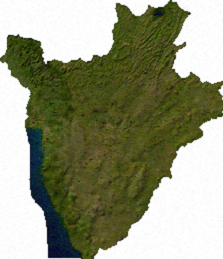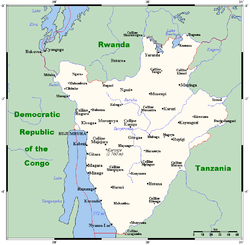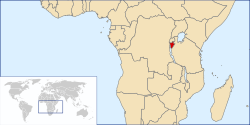Top Qs
Timeline
Chat
Perspective
Geography of Burundi
From Wikipedia, the free encyclopedia
Remove ads
Burundi is located in East Africa, to the east of the Democratic Republic of the Congo, at the coordinates 3°30′S 30°0′E.
This article needs additional citations for verification. (February 2013) |




Remove ads
Physical geography
Summarize
Perspective
Burundi occupies an area equal to 27,830 square kilometres (10,750 sq mi) in size, of which 25,680 square kilometres (9,920 sq mi) is land. The country has 1,140 kilometres (710 mi) of land border: 236 kilometres (147 mi) of which is shared with the Democratic Republic of the Congo, 315 kilometres (196 mi) with Rwanda and 589 kilometres (366 mi) with Tanzania. As a landlocked country, Burundi possesses no coastline. It straddles the crest of the Congo–Nile Divide which separates the basins of the Congo and Nile rivers. The farthest headwaters of the Nile, the Ruvyironza River, has its source in Burundi.
Terrain
The terrain of Burundi is hilly and mountainous, dropping to a plateau in the east. The southern and eastern plains have been categorised by the World Wide Fund for Nature as part of the Central Zambezian miombo woodlands ecoregion.
The lowest point in the country is at Lake Tanganyika, at 772 metres (2,533 ft), with the highest point being on Mount Heha, at 2,684 metres (8,806 ft).[2] Natural hazards are posed in Burundi by flooding and lands.
Forests
In Burundi forest cover is around 11% of the total land area, equivalent to 279,640 hectares (ha) of forest in 2020, up from 276,480 hectares (ha) in 1990. In 2020, naturally regenerating forest covered 166,670 hectares (ha) and planted forest covered 112,970 hectares (ha). Of the naturally regenerating forest 23% was reported to be primary forest (consisting of native tree species with no clearly visible indications of human activity) and around 41% of the forest area was found within protected areas. For the year 2015, 100% of the forest area was reported to be under public ownership.[3][4]
Natural resources
Burundi possesses reserves of: nickel, uranium, rare earth oxides, peat, cobalt, copper, platinum (not yet exploited), vanadium, niobium, tantalum, gold, tin, tungsten, kaolin, and limestone. There is also arable land and the potential for hydropower. Burundi has 214.3 square kilometres (82.7 sq mi) of land that is irrigated. The table below describes land use in Burundi.
Remove ads
Climate
The climate of Burundi is equatorial in nature and is marked by high mean annual temperatures, small temperature ranges, and rainfall throughout the year.[5] The temperature and amount of rainfall varies dependent upon altitude.[6] Burundi experiences its dry season between May and August, and its rainy season between February and May.[6] Due to climate change, Burundi is becoming more susceptible to both excess and deficit rainfall, leading alternately to floods and droughts.[7]
Remove ads
Environment
Summarize
Perspective
Current issues
In Burundi, soil erosion poses a significant challenge, exacerbated by overgrazing and the expansion of agriculture into marginal lands. This problem is compounded by other environmental issues such as deforestation, driven by the uncontrolled cutting of trees for fuel, and habitat loss, which severely threatens wildlife populations. The cumulative effect of these issues not only degrades the environment but also undermines the agricultural productivity that is crucial for the country's economy and food security. The "Adapting to Climate Change in the Lake Victoria Basin" project, initiated by the United Nations Environment Programme (UNEP) and funded by the Adaptation Fund, addresses these interconnected concerns. By promoting nature-based solutions like reforestation and the construction of terraces, the project helps stabilize the soil and improve water retention, which mitigates the impact of soil erosion. Additionally, the introduction of sustainable practices such as the eco-friendly fish-drying kiln helps reduce the dependence on wood for fuel, thereby curbing deforestation. This comprehensive approach not only aims to enhance environmental resilience but also supports sustainable development by preserving natural habitats and promoting the sustainable use of resources, thereby securing the livelihoods of local communities against the backdrop of climate change.[8]

International agreements
Burundi is a party to the following international agreements that relate to the environment: Biodiversity, Climate Change, Desertification, Endangered Species, Hazardous Wastes and Ozone Layer Protection. The following have been signed but not yet ratified by Burundi: Law of the Sea and Nuclear Test Ban.
Extreme points
This is a list of the extreme points of Burundi, the points that are farther north, south, east or west than any other location.
- Northernmost point – Muyinga Province; unnamed location on the border with Rwanda immediately south of the Rwandan town of Mbuye
- Easternmost point – Cankuzo Province; unnamed location on the border with Tanzania immediately northwest of Mburi hill
- Southernmost point – Makamba Province; unnamed location on the border with Tanzania immediately north of the Tanzanian town of Mwenene,
- Westernmost point – Cibitoke Province; unnamed location on the border the Democratic Republic of the Congo immediately east of the Congolese town of Kamanyola
Remove ads
References
Wikiwand - on
Seamless Wikipedia browsing. On steroids.
Remove ads


